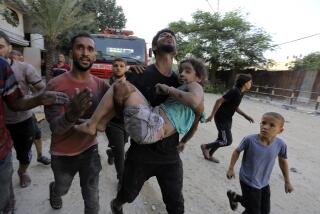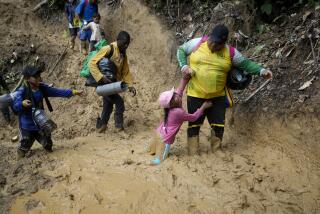The Unwanted Children: Casualties Left by a Tyrant : Romania: Abandoned youngsters fill orphanages that resemble warehouses. Aid does not always reach them.
- Share via
TURNU ROSU, Romania — In a 108-year-old building lacking hot water, flush toilets and a telephone, 234 young girls with shorn heads and ragged clothing spend their days embroidering napkins to sell to tourists.
These are the survivors of a rigorous and deprived childhood, weathering starvation rations, heatless winters and years of neglect in Romania.
The girls at Turnu Rosu are said to be mildly retarded, emotionally scarred by impersonal upbringing and a lifetime without human touch. Many could be rescued with special education, but the adjacent school has only two teachers. Training to aid the handicapped ceased in 1978, when tyrant Nicolae Ceausescu turned his back on the misfit offspring of his tortured society.
Institutions like this one warehousing Romanian children could afford a better diet now that the government has doubled food allowances. But store shelves in impoverished Romania are as empty for orphans as for everyone else, so the wards of Turnu Rosu still subsist on bread and fatty sausage.
They spend aimless hours in the dirt yard of their fenced institution, or roaming the peeling corridors of a dormitory that reeks of sewage and mold. Most are clad in cloth slippers and thin sweaters, although piles of warm winter clothing arrived weeks ago from Austria. The donations remain unsorted for lack of matrons’ time, or interest, or both.
Romania is overwhelmed with the burden of abandoned children, the human casualties of Ceausescu’s maniacal quest for a nation of 30 million by the end of the century. Even statistically, the campaign was a failure; the average family continues to have fewer than three children and the population is about 23 million.
But in the course of it, unwanted youngsters piled up by the thousands amid bans on birth control and abortion. To guard against self-inflicted termination of pregnancies, Ceausescu’s “baby police” tested female workers monthly to detect and track each conception.
Intrusion into family planning ended with last December’s revolution, which overthrew and killed Ceausescu. Now the number of abandoned newborns has drastically fallen. Still, 200,000 of “Ceausescu’s children” survive in squalid institutions that have been little improved in the year since the dictator’s fall.
Horrid scenes from the worst of the homes have jarred Western aid agencies into action. Television documentaries showing deformed children lashed to rusting iron cots with urine-soaked mattresses have prompted an international outpouring of money, clothing, toys and medicines. Dozens of relief workers from Western Europe and the United States have been drawn to Romania by the pictures of untended toddlers, rocking monotonously in soiled cribs, wearing stunned expressions at the unfamiliar feel of a caress.
But the most troubling legacy of Ceausescu may be his systematic destruction of human values, which international aid and government good intentions have been powerless to repair.
Indifference toward abandoned children persists among Romanians because too many here are absorbed in a battle for their own survival.
“You can’t take care of someone else unless your own little corner of the world is taken care of,” said Stefan Toma, aid coordinator here for World Vision, a Pasadena-based Christian relief and development organization. “You can’t blame the staff at these places. It’s so difficult to take care of their own families that many Romanians have had to shut their eyes to other problems.”
Turning off emotionally was a defense mechanism for the state home workers, who were helpless to ease the suffering inflicted on their wards when Ceausescu cut heating and food supplies for those deemed unworthy of life in the perfect society he sought to build. In the worst of the homes, a dozen facilities for the “unsalvageable,” as many as 50% of the children died each winter, according to Barbara Bascom, an American pediatrician working with World Vision.
Those working with the staff of orphanages, such as Rene Stidi of the Swiss Red Cross, say the most effective aid is providing an example for Romanians never before expected to get involved.
“The Western people who are coming here and showing the Romanian people their devotion to these children, their willingness to care--this is the greatest contribution that can be made,” said Prime Minister Petre Roman recently, decrying the attitude of “indifference” among many Romanians.
“I make no condemnation of these people,” Stidi said of the orphanage workers. “When you have matrons responsible for feeding, clothing and keeping clean 40 children in horribly undersupplied homes, it’s not fair to pass judgment on them.”
Preparing a new class of committed professionals will take about five years, predicted Deputy Health Minister Emil Tomescu.
“A change in mentality cannot be made within a few months,” the Bucharest official said. “This breakdown in responsibility was a progressive degradation.”
A lack of qualified personnel, of both care-givers and maintenance workers, is the most tenacious obstacle to improving conditions in the orphanages, said Dorel Ritivoi, the deputy director of the Turnu Rosu facility.
“It’s very difficult to get people who are morally suited to this work,” said Ritivoi, noting his own salary of 2,600 lei, or about $74 a month at the inflated official exchange rate. “Conditions are the same at all the rural institutions, because when people are allowed to change jobs freely, they all run for the nearest city. We lost 10 of our best workers this fall, as anyone not tied down here got out.”
At an orphanage in the Transylvanian town of Fagaras, director Viorica Popa described how a shortage of good matrons allows a destructive internal pecking order to set in.
“Christina is one of the shoe-polishers,” Popa said, ruffling an ostracized 10-year-old’s bristly hair, shorn to the scalp in a recent delousing.
There are other problems.
Resentment of the relative plenty being lavished on infants in some institutions, like the Codlea home for 3- to 6-year-olds where the Swiss have been helping for months, occurs in communities where many families suffer the same hardships as the state homes.
“There have been many times when our own children didn’t get three meals a day,” said Antigona Pripis, director of the Codlea home.
Much of the aid sent earlier this year was stolen by desperate villagers wanting shoes, coats and playthings for their own children.
Another problem is the structural deficiencies at the decrepit institutions. Volunteers have tackled the mountain of tasks but repairs often languish for want of a spare part or capable hands to complete them.
At the Turnu Rosu dormitory, built in 1882, a bank of shiny new sinks stands in the center of a mildewed bathroom. Two West German handymen with the Roman Catholic Church’s Caritas aid society began work on the plumbing in early fall but left hurriedly when one fell ill. The children still wash and shower in ice-cold water.
“There is no one here to finish the job,” explained deputy director Ritivoi.
The sheer number of abandoned children has given rise to a wave of adoptions and the disturbing phenomenon of Westerners shopping for children. Adults seeking Caucasian orphans have descended on Romania in droves, prowling the state homes “as if looking at animals in a zoo,” complained Stidi, the Swiss Red Cross official.
Most of the attention of foreign volunteers has been trained on the youngest orphans, those most wanted for adoption. But most of those in state care, about 190,000 of the 200,000, are older than 3, but are in equal need, said Deputy Health Minister Tomescu.
Nearly 1,000 Romanian children have been adopted this year, and foreign embassies say at least that number of adoptions are pending, as interest accelerated after a new law in July that clarified the procedures.
Prospective parents select the child they want by visiting homes for the abandoned, then tracking down the natural parents through regional courts to get permission to take them.
But in the emotionally battered environment of post-Ceausescu Romania, the run on adoption has stirred both false hopes in some children and unscrupulous opportunism among lawyers and birth parents.
Toddlers barely able to talk approach visiting strangers, calling out, “Mama,” or, “Take me,” competing for the rare privilege of being wanted. At the Fagaras home on a mid-November morning, an Italian couple pored over one excited girl’s schoolwork while a handful of others watched plaintively from the doorway.
Greedy middlemen roused by the scent of hard currency ferry bribes to parents and court officials to speed the adoption process that can take anywhere from a few hours to several months, said Bucharest lawyer Corin Danescu.
“Children are given with priority to those foreigners who pay the best ‘expenses,’ ” the lawyer observed.
“We sell our children too easily,” Romanian journalist Olbojan Ionescu wrote in an article for the Bucharest weekly Zig-Zag, detailing the new black market in babies and toddlers.
Romanian adoption law does not forbid financial compensation to the natural parents, who are increasingly asking for payoffs in return for giving up all rights to their abandoned children.
“We’ve been hearing stories of different lawyers and intermediaries charging a wide variety of fees,” said Ann Gordon of the U.S. Consulate in Bucharest. “The culture here is to give gifts. But there are things we hear of being done that we would consider questionable.”
Foreign governments have been keeping their distance from the process, stepping in only to grant emigration papers after being presented with proof that the adoption was legal.
The U.S. Consulate provides an information packet for Americans seeking to adopt, which strongly recommends early testing for the AIDS virus, as a positive result poses a barrier to U.S. immigration.
At least 1,000 Romanian children have been diagnosed as suffering from acquired immune deficiency syndrome, spread by contaminated needles reused repeatedly to inject weak newborns with adult blood in the belief that it fortified them.
The AIDS babies, like the school-age children, are destined to be left in the institutions, which World Vision’s Toma says is the best incentive to fight for improvement, despite the odds.
“You see this kind of suffering so often that you just can’t work on emotions,” Toma said. “But it gets you when you least expect it.”
More to Read
Sign up for Essential California
The most important California stories and recommendations in your inbox every morning.
You may occasionally receive promotional content from the Los Angeles Times.













